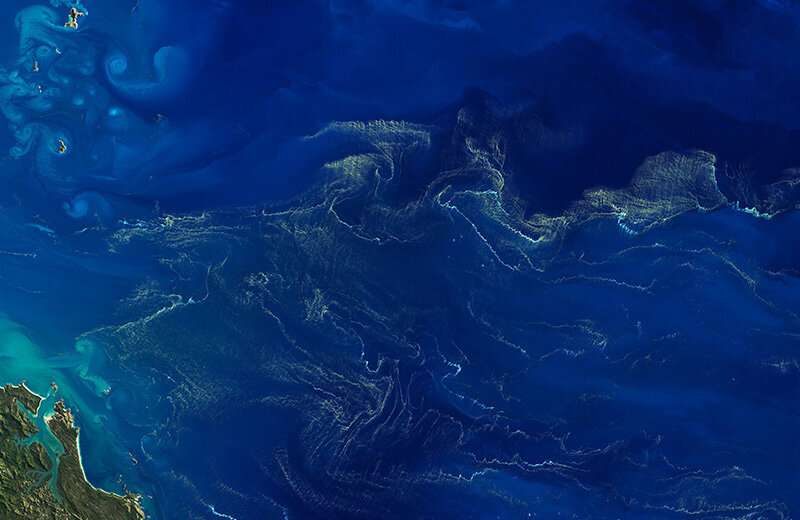Life on Earth may be carbon-based, but another element matters, too

Middle school students learn in science class about the carbon cycle—the flow of carbon among the atmosphere, living organisms, soil and the oceans. But another, less familiar cycle also plays a crucial role in the balance of nature: the nitrogen cycle.
Nitrogen constitutes about 78% of the Earth's atmosphere, where it exists mainly in its most stable form, a gas called dinitrogen, or N2. A significant amount also resides in the oceans as dissolved gas.
Most animals and plants can't use N2; they first need it turned into a more reactive form, such as ammonia, through a process called nitrogen fixation. But only certain microorganisms can fix nitrogen, and many of those live in marine environments. They draw the N2 from the water and, using a specialized enzyme, break the bond between the two nitrogen atoms and attach other atoms to each, making new molecules that other living organisms can use.
The process is crucial to life on Earth and directly affects humans.
"The oceans are becoming an ever-increasing source of food for humanity, and nitrogen fixation is critical in maintaining many marine food webs," said Doug Capone, professor of biological sciences at the USC Dornsife College of Letters, Arts and Sciences. His research focuses on understanding how ocean microbes affect the movement of important elements, including carbon and nitrogen, through plants and animals and from land to sea to air and back.
Getting a fix on global fixation
Capone has studied diverse ecological systems throughout the world, including the tropical open ocean, coral reefs, mangroves, temperate estuaries, groundwater aquifers and Antarctic snows.
A thorough understanding of the factors involved in nitrogen fixation in the oceans could help future generations safely and sustainably farm the oceans, he said.
Capone, collaborating with Jonathan Zehr of the University of California, Santa Cruz, recently published Marine Nitrogen Fixation (Springer, 2021), which summarizes the extensive research and current understanding of marine nitrogen fixation. The book builds on an article the pair wrote and published last year at the request of the journal Science.
Capone, who holds the William and Julie Wrigley Chair in Environmental Studies, and Zehr, a Distinguished Professor at UC Santa Cruz, are widely respected authorities on marine nitrogen fixation.
"I've been working on aspects of marine N2 fixation since my days as a Ph.D. student," Capone said. His dissertation focused on the importance of N2 fixation in the tropical seagrass Thalassia, also known as turtle grass.
In shallow tropical waters, turtle grass forms dense "meadows" that many sea-going species—from microbes to mollusks to manatees—call home. Nitrogen-fixing microbes, known scientifically as diazotrophs, live on the plant's leaves and its roots, providing a critical source of nitrogen in the nutrient-depleted tropical waters, Capone said.
Combined expertise in a vital field of study
After landing his first faculty position at New York's Stony Brook University in the late '70s, Capone turned his attention to the open ocean, and in the decades since, he has led many research cruises to locations throughout the globe and conducted extensive research on the physiology, ecology and biogeochemical impact of open ocean diazotrophs.
He's also spent a large share of his career mentoring young scientists and brought many others into this field.
"I've trained a gaggle of researches in this area—undergrads, grad students and postdocs—as well as having entrained researchers from diverse fields into the area of marine nitrogen fixation," he said.
Zehr is among those researchers, having joined Capone's Stony Brook University Lab as a postdoctoral fellow in 1980.
"His postdoc with me was not on N2 fixation, but he subsequently joined me on many of the cruises I led to study this process in the tropical ocean," said Capone.
Zehr has gone on to establish one of the best model systems for studying functional genes in the environment, according to Capone. Major advances in uncovering the vast biodiversity of microbes in the environment have generally relied upon analyzing the ribosomal genes—genes involved in creating ribosomes—that are common to all life to establish relationships and diversity. Zehr has instead used the genes directly involved with nitrogen fixation to find and characterize previously unknown microbes capable of fixing N2 in the ocean and to track the expression of these genes.
Well-known for his work among the tiniest marine plankton, Zehr discovered a biological partnership, or symbiosis, of two microorganisms found throughout much of the world's upper ocean.
One partner, the host alga, is eukaryotic—meaning it has a nucleus and is autotrophic, able to use light energy and fix carbon; that is, take up carbon dioxide to feed itself and produce new organic molecules.
The other partner is a small, unicellular cyanobacterium, or blue-green alga, that can also derive energy from light but is unable to fix carbon. However, it does fix N2.
The two exchange metabolites in their symbiosis, and the cyanobacterium is a major player in fixing N2 in the oceans, says Capone, who also hints that his and Zehr's combined expertise is a kind of symbiosis in its own right, making them particularly well-suited to put together Marine Nitrogen Fixation.
"In many ways, we complement each other—Jon on the molecular biology, physiology and biogeography of nitrogen fixation, myself focusing on ecology and biogeochemistry," Capone says.
In the book, which is primarily intended for scientists, graduate students and upper division undergraduates, he and Zehr give a detailed overview of the current understanding of global marine nitrogen fixation. Topics include which marine microorganisms are fixing nitrogen, where they live and what environmental factors—including human-caused changes such as ocean warming and acidification—impact microbial activity. And they point out that much about the physiology and regulation of N2 fixation remains to be uncovered.
More information: Marine Nitrogen Fixation: www.springer.com/gp/book/9783030677459
Journal information: Science
Provided by University of Southern California


















